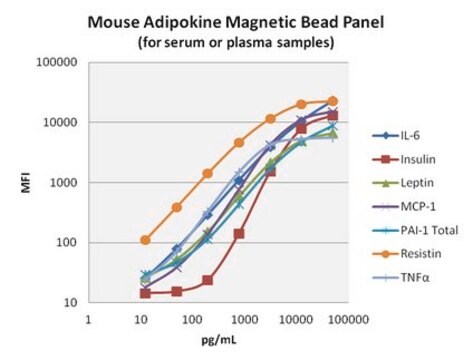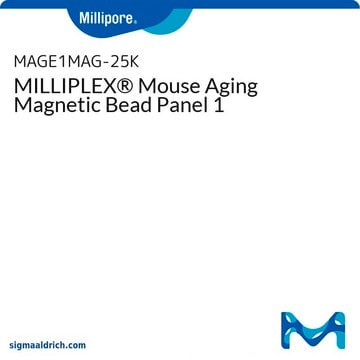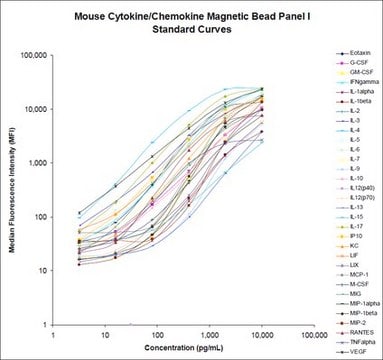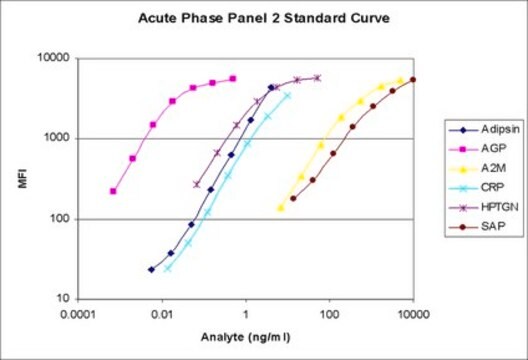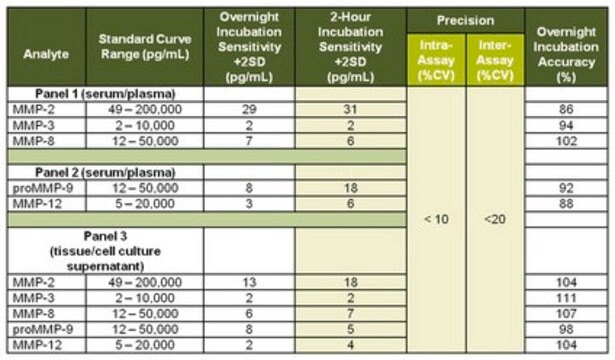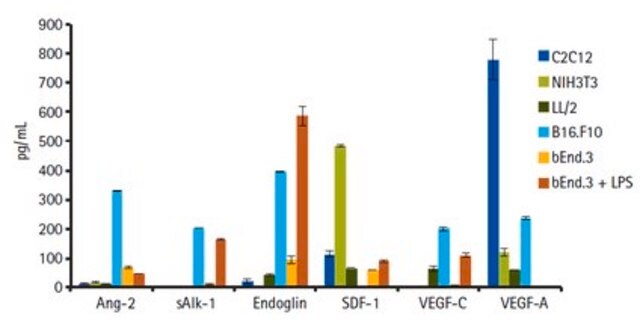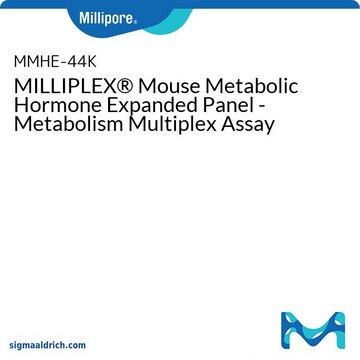MMYOMAG-74K
MILLIPLEX® Mouse Myokine Magnetic Bead Panel
Inflammation/Immunology Bead-Based Multiplex Assays using the Luminex technology enable the simultaneous analysis of multiple myokine and cytokine biomarkers in mouse serum and plasma samples.
About This Item
Empfohlene Produkte
Qualitätsniveau
Speziesreaktivität
mouse
Hersteller/Markenname
Milliplex®
assay range
accuracy: 3-40,000 pg/mL
(Osteocrin)
standard curve range: 0.6-9,000 pg/mL
(BDNF)
standard curve range: 128-2,000,000 pg/mL
(Osteonectin (SPARC))
standard curve range: 16-250,000 pg/mL
(Oncostatin M)
standard curve range: 22-350,000 pg/mL
(EPO)
standard curve range: 256-4,000,000 pg/mL
(Myostatin)
standard curve range: 26-400,000 pg/mL
(26Irisin)
standard curve range: 3-40,000 pg/mL
(LIF)
standard curve range: 3-40,000 pg/mL
(Osteocrin/Musclin (OSTN))
standard curve range: 48-750,000 pg/mL
(IL-15)
standard curve range: 5-75,000 pg/mL
(FGF21)
standard curve range: 9-140,000 pg/mL
(IL-6)
inter-assay cv: <15%
intra-assay cv: <10%
Methode(n)
multiplexing: suitable
Nachweisverfahren
fluorometric (Luminex xMAP)
Versandbedingung
ambient
Allgemeine Beschreibung
MILLIPLEX® Mouse Myokine Panel is a 12-plex kit to be used for the simultaneous quantification of any or all of the following analytes in serum, plasma, and tissue culture samples: Brain-derived Neurotrophic Factor (BDNF), Erythropoeitin (EPO)*, Fibroblast Growth Factor 21 (FGF21), Follistatin-Like Protein 1 (FSTL-1), IL-6, IL-15, Irisin, Leukemia Inhibitory Factor (LIF), Myostatin (MSTN / GDF8), Oncostatin M (OSM), Osteocrin/Musclin (OSTN), Osteonectin (SPARC).
*Only available for cells culture samples.
This kit uses a 96-well format, contains a lyophilized standard cocktail, two internal assay quality controls and can measure up to 38 samples in duplicate.
The Luminex® xMAP® platform uses a magnetic bead immunoassay format for ideal speed and sensitivity to quantitate multiple analytes simultaneously, dramatically improving productivity while conserving valuable sample volume.
Panel Type: Metabolism
Anwendung
- Analytes: Brain Derived Neurotrophic Factor (BDNF), Erythropoietin (EPO), Fibroblast Growth Factor 21 (FGF-21), Follistatin-like Protein 1 (FSTL1), IL-6, IL-15, Irisin, Leukemia Inhibitory Factor (LIF), Myostatin (MSTN/GDF8), Oncostatin M (OSM), Osteocrin (OSTN/Musclin), Osteonectin (SPARC)
- NOTES: BDNF - Substantial amounts of BDNF are stored in circulating platelets and subsequently released upon platelet activation. Therefore, platelet-poor plasma is critical to ensure accurate measurement of circulating levels of BDNF. OSM - While OSM is barely detectable in the serum/plasma of healthy subjects, a slight increase can be observed in certain disease states. Higher measurements in cell culture samples have also been reported. Erythropoeitin (EPO) is for tissue culture samples only and cannot be combined with other analytes in this panel when measuring serum or plasma.
- Recommended Sample Type: Mouse serum, plasma, or cell/tissue culture supernatants or lysates
- Recommended Sample Dilution: 25 μL per well of 1:2 diluted serum or plasma; cell/tissue culture samples may require dilution in an appropriate control medium.
- Assay Run Time: For greater sensitivity an overnight incubation is recommended, (16-18 hours) at 2-8°C. Alternatively, incubate for 2 hours at room temperature (20-25°C).
- Research Category: Metabolism
- Research Subcategory: Obesity, Metabolic Disorders, Inflammation
Leistungsmerkmale und Vorteile
Sonstige Hinweise
Rechtliche Hinweise
Signalwort
Danger
Gefahreneinstufungen
Acute Tox. 4 Dermal - Acute Tox. 4 Inhalation - Acute Tox. 4 Oral - Aquatic Chronic 2 - Eye Dam. 1 - Skin Sens. 1 - STOT RE 2
Zielorgane
Respiratory Tract
WGK
WGK 3
Analysenzertifikate (COA)
Suchen Sie nach Analysenzertifikate (COA), indem Sie die Lot-/Chargennummer des Produkts eingeben. Lot- und Chargennummern sind auf dem Produktetikett hinter den Wörtern ‘Lot’ oder ‘Batch’ (Lot oder Charge) zu finden.
Besitzen Sie dieses Produkt bereits?
In der Dokumentenbibliothek finden Sie die Dokumentation zu den Produkten, die Sie kürzlich erworben haben.
Verwandter Inhalt
Myokine analysis with multiplex immunoassays, such as the MILLIPLEX® Human Myokine Panel, allow researchers to simultaneously measure multiple muscle-secreted factors, providing more insights into related diseases.
Unser Team von Wissenschaftlern verfügt über Erfahrung in allen Forschungsbereichen einschließlich Life Science, Materialwissenschaften, chemischer Synthese, Chromatographie, Analytik und vielen mehr..
Setzen Sie sich mit dem technischen Dienst in Verbindung.